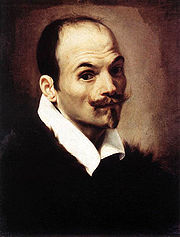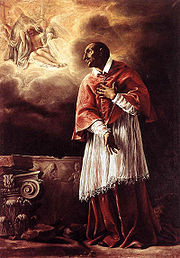
Orazio Borgianni
Encyclopedia


Italy
Italy , officially the Italian Republic languages]] under the European Charter for Regional or Minority Languages. In each of these, Italy's official name is as follows:;;;;;;;;), is a unitary parliamentary republic in South-Central Europe. To the north it borders France, Switzerland, Austria and...
painter and etcher of the Mannerist
Mannerism
Mannerism is a period of European art that emerged from the later years of the Italian High Renaissance around 1520. It lasted until about 1580 in Italy, when a more Baroque style began to replace it, but Northern Mannerism continued into the early 17th century throughout much of Europe...
and early-baroque
Baroque
The Baroque is a period and the style that used exaggerated motion and clear, easily interpreted detail to produce drama, tension, exuberance, and grandeur in sculpture, painting, literature, dance, and music...
periods. He was the stepbrother of the sculptor and architect Giulio Lasso
Giulio Lasso
Giulio Lasso was an Italian architect, best known for his work in Palermo, Sicily. He was born in Florence.His most famous work is the Quattro Canti, an eight sided piazza in the centre of Palermo...
.
Borgianni was born in Rome
Rome
Rome is the capital of Italy and the country's largest and most populated city and comune, with over 2.7 million residents in . The city is located in the central-western portion of the Italian Peninsula, on the Tiber River within the Lazio region of Italy.Rome's history spans two and a half...
, where he was documented in February 1604. He was instructed in the art of painting by his brother, Giulio Borgiani, called Scalzo. The patronage by Philip II of Spain
Philip II of Spain
Philip II was King of Spain, Portugal, Naples, Sicily, and, while married to Mary I, King of England and Ireland. He was lord of the Seventeen Provinces from 1556 until 1581, holding various titles for the individual territories such as duke or count....
induced him to visit that Spain, where he signed an inventory in January 1605. He returned to Rome from Spain after April 1605 at the height of his career, and most of the work of his maturity was carried out 1605-16. In Spain, he signed a petition to begin an Italianate academy of painting and executed a series of nine paintings for the Convento de Portacoeli, Valladolid, where they remain. From his time in Spain, there remain two of his paintings in the Prado Museum: St Christopher and the Stigmatization of St Francis.
On his return to Rome
Rome
Rome is the capital of Italy and the country's largest and most populated city and comune, with over 2.7 million residents in . The city is located in the central-western portion of the Italian Peninsula, on the Tiber River within the Lazio region of Italy.Rome's history spans two and a half...
he was patronized by the Spanish ambassador, for whom he painted several pictures, and he was also employed in painting for the churches. He painted as late as 1630. after which he returned to Spain
Spain
Spain , officially the Kingdom of Spain languages]] under the European Charter for Regional or Minority Languages. In each of these, Spain's official name is as follows:;;;;;;), is a country and member state of the European Union located in southwestern Europe on the Iberian Peninsula...
. He frescoed in the apse of the church of San Silvestro in Capite
San Silvestro in Capite
The Church of Saint Sylvester in Capite is a Roman Catholic minor basilica and titular church in Rome dedicated to Pope Saint Sylvester I. Built in the 8th century as a shrine for the relics of the saints and martyrs from the Catacombs, the church is the National church of Great Britain.The Latin...
in Rome, a Martyrdom of S.Stefano I and a Messengers of Constantine call on Saint Silvestro (1610). His canvas of San Carlo Borromeo in the church of San Carlo alle Quattro Fontane
San Carlo alle Quattro Fontane
The Church of Saint Charles at the Four Fountains is a Roman Catholic church in Rome, Italy. Designed by the architect Francesco Borromini, it was his first independent commission. It is an iconic masterpiece of Baroque architecture, built as part of a complex of monastic buildings on the Quirinal...
(1612) is an eclectic and emotive synthesis of both Carracci
Accademia degli Incamminati
The Accademia degli Incamminati was one of the first art academies in Italy. It was originally created around 1580 in Bologna as the Accademia dei Desiderosi and was sometimes known as the Accademia dei Carracci after its founders the Carracci cousins , with Annibale heading the institution thanks...
and tenebrist styles. The influence of Caravaggio
Caravaggio
Michelangelo Merisi da Caravaggio was an Italian artist active in Rome, Naples, Malta, and Sicily between 1593 and 1610. His paintings, which combine a realistic observation of the human state, both physical and emotional, with a dramatic use of lighting, had a formative influence on the Baroque...
is also evident in a painting of the same saint (1616) now in the Hermitage Museum. A lively self-portrait of an earnest, somewhat foppish Borgianni is in the Rome Galleria Nazionale d'Arte Antica.

Giovanni Baglione
Giovanni Baglione was an Italian Late Mannerist and Early Baroque painter and art historian. He is best remembered for his acrimonious involvement with the artist Caravaggio and his writings concerning the other Roman artists of his time.-Early life:A pupil of Francesco Morelli, he worked mainly...
, who leans heavily on anecdote. He is said to have had a temper; riding one day in a coach, at Rome, he saw some artists, among whom was Caravaggio, laughing at him; he sprang from the carriage, seized a bottle of varnish from the shop of a druggist, and threw it at the heads of the offenders.
As an engraver he etched a
- Resurrection.
- A composition of many figures; marked two Marys and St. John; dated 1615.
- St. Christopher giving his hand to the Infant Jesus.
- St. Christopher carrying the Infant on his Shoulder.
- Fifty-two Bible histories, called Raphael's Bible.
- The dead Christ, in a foresbortened position, 1615.

